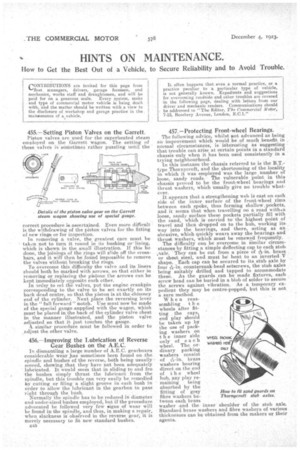HINTS ON MAINTENANCE.
Page 32

If you've noticed an error in this article please click here to report it so we can fix it.
How to Get the Best Out of a Vehicle, to Secure Reliability and to Avoid Trouble.
455,—Setting Piston Valves on the Garrett.
Piston valves are used for the superheated steam employed on the Garrett wagon. The setting of these valves is senietiineS rather puzzling until the • correct procedure is ascertained. Even more difficult is the withdrawing of the piston valves for the fitting of new rings or for inspection.
In removing a valve, the greatest care must be taken not to turn it round in its bushing or 'lining, which is shown in the, small illustration. If this be done, the joinings of the rings will slide off the crossbars, and it will then be found impossible to remove the valves Without breaking the rings.
To overcome this difficulty the valve and its liners should both be marked with arrows, so that either in removing or replacing the pietons the arrows can be kept immediately opposite each other. in order to set the valves, put the engine crankpin corresponding to the valve to be set exactly on its back dead centre, so that the piston is at the chimney end of the cylinder. Next place the reversing lever in the "full forward "'notch. Use must now be made of the, special gauge ,supplied with the Wagon, which must he placed in the back of the cylinder valve chest in the manner illustrated, and the piston valve adjusted so that it just touches the gauge. A. similar procedure must be followed in order to _adjust the other valve.
456.—Improving the Lubrication of Reverse Gear Bushes on the A.E.C.
In dismantling a large number of A.E.C. gearboxes considerable weak has sometimes been found on the. spindle and bushes of the reverse, both being usually scored, showing ,that they have not been adequately lubricated. It would seem that in sliding to and fro the bushes simply thrust the lubricant from the spindle, but this trouble can very easily be remedied 'isy cutting or filing 'a slight groove in each bush in order to allow the lubricant in the gearbox to pass right through the bush.
Normally the spindle has to be reduced in diameter and under-sized bushes employed, but if the procedure advocated be followed very few signs of wear will be found in the spindle." and thus in making a repair, when slackness is' observed in the reverse gear', it is merely necessary to fit new standard bushes.
134.8
457.—Protecting Front-wheel Bearings.
The following advice, whilst sot advanced as being an improvenaent which would be of much benefit in . normal circumstances, is interesting as suggesting that trouble can arise at certain points in a standard chassis only when it has been used consistently in a trying neighbourhood. In this instance the chassis referred to is the B.T.type Thornycroft, and the shortcoming of the locality in which it was employed was the large number of loose, sandy roads.. The vulnerable point in this chassis proved to be the front-wheel bearings and thrust washers, which 'usually give no trouble whatever.
It appears that a strengthening web is cast on each side of the inner surface of the front-wheel rims between each spoke, thus forming shallow .pockets, and it seems that when travelling on a road with.a loose, sandy surface these pockets partially fill with the sand, which is carried to the highest point of travel and then drOpped on to the hub, working its way into the bearings, and there, acting as an abrasive, which quickly wears away the bearings and thrust washers, which must be renewed frequently.
The difficulty can be overcome in similar circumstances by fitting a simple deflecting cap to each stub ,axle. They can be cut from a piece of ?e-in. brass or sheet steel, and must be bent to an inverted IT shape. Each cap can be secured to its stub axle by four countersunk head setscrews, the stub axles being suitably drilled and tapped to accommodate these. As the guards can be made fixtures, each screw head can be buried in a blob of solder to secure the screws against vibration. As a temporary expedient they may be centre-popped, but this is not a sure method.
When reassembling t h e wheels after fit ting the caps, end play should be taken up by the use of packing washers on t h e inner side only of each wheel. The or dinary packing
washers consist of-2,-in. brass
washers bearing direct on the end of the wheel hub, any play remaining being absorbed by the fitting of grey How to fit sand guards on
fibre washers beThornycroft stub axles.
tween each brass washer and the inner shoulder of the stub axle. Standard brass washers and fibre washers of various thicknesses can be obtained from the makers or their agents.


































